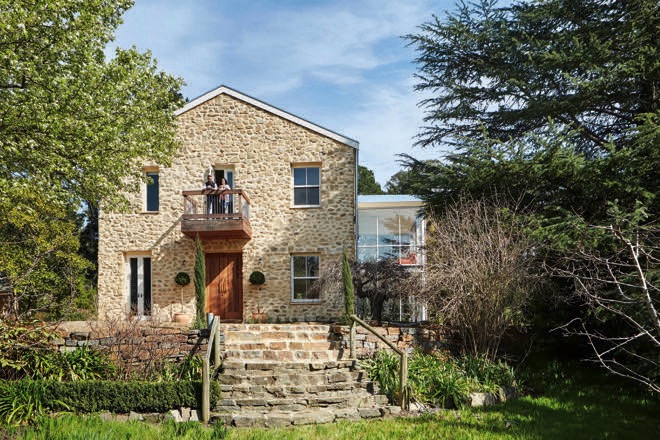Blending a rustic stone exterior with an innovative two-storey glass box, the Stirling Glass Stone House is a new family home with centuries of character
The old saying about glass houses and throwing stones didn’t deter homeowner Louise Sergi and her family from building a heavy-set stone house and adjoining double-storey glass box.
The family of five was originally living in a small double-brick 1970s two-bedroom house with an asbestos roof set in the middle of an English-style two-acre (0.8 hectare) property with a rambling garden. With more children than space to accommodate them comfortably, Louise and her husband, Steve, considered the possibility of a major renovation and remodel of the original building. They quickly dismissed this option after concluding it would lead to a compromised solution, instead settling on a complete rebuild.
The brief they delivered to architect Damien Chwalisz was for a rustic stone farmhouse with castle-thick walls. From the outside, the owners wanted the home to look as though it had always been there while on the inside, they desired a contemporary design with an open-plan layout.
Most importantly, the Stirling Glass Stone House needed to complement the established garden layout. Inspired by the rustic stone buildings in southern Europe and, more locally, the Adelaide Hills, Louise hoped to emulate their stylish, warm and inviting atmospheres, which effortlessly complement their surrounding landscapes. As such, more than 150 tonnes of stone was hauled to site to begin construction on the four-bedroom, three-bathroom home, with a study, open-plan kitchen, dining area and two open-plan living spaces. In keeping with the local environment, the stone was sourced from Basket Range Sandstone in the Adelaide Hills.
“As silly as it sounds, we were extremely excited when the slab was poured,” says Louise. “We had been planning the building for seven years and often felt like it would remain a dream. So to see the first step in action was fantastic. It was particularly memorable when the scaffolding around the house was removed (at the completion of the stonework), as it was the first time that we were able to see the completed stone building in an uninterrupted way.”
Skilled stonemason’s worked on the north-facing structure for four months, painstakingly laying each stone with a special mortar colour that gave the structure an antiquated appeal. To complement the earthy hues of the stone, 100-plus-year-old reclaimed timber doors, cabinetry and Oregon floors were used to produce a warm and comfortable atmosphere. “The home was never intended to be ornate or fancy but to be very natural and functional for a busy family who spend much of our time in the garden,” says Louise, adding that she wanted the house to possess a sense of height and openness, which the architect achieved by installing high ceilings and multiple void areas. Double-leaf stonewalls keep the structure cosy and provide much-needed thermal protection.
Adjoining this traditional stone building is a two-storey glass box. The unconventional appendage welcomes light and drama to the setting, and allows the family to sit among the garden without going outside. From this vantage point, immersive views of the garden and valley beyond can be enjoyed without interruption and without fear of frostbite during the chilly Adelaide Hills winters. “The glass box was included after the original stone building design had been complete,” says Louise. “From a design perspective, the light and modern glass box was included to create an element of contrast to the tradition and heaviness of a stone building. Pragmatically, the glass box also provided additional space and an opportunity to really bring the garden inside.”
Remaining true to their conviction to build an entire home using local, uncut, random stones, the Stirling Glass Stone House offers a transparent look at the future of “traditional” builds and reminds us of the charm of solid stone walls, a feature seldom seen in contemporary structures.

































